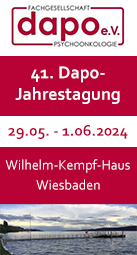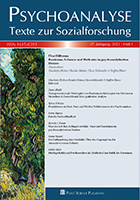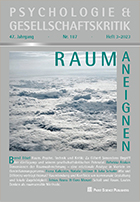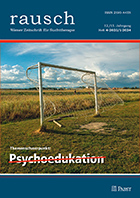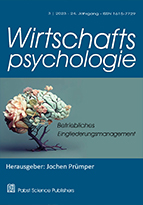Validity of the Anadolu-Sak Intelligence Scale in the identification of gifted students
Ugur Sak, Bilge Bal Sezerel, Esranur Dulger, Kubra Sozel & M. Bahadir Ayas
PDF of the full article
Early music experiences and IQ: Identification of a “Gifted Learning Pathway”
Marold Reutlinger, Anke Elisabeth Ballmann, Wolfgang Pfeiffer, Wilma Vialle & Albert Ziegler
PDF of the full article
Relative weaknesses in visual-motor skills und visual-spatial perception as risk factors inhibiting the development of gifted children and adolescents: an analysis of AID 3 intelligence-test profiles for children with superior intelligence
Stefana Holocher-Ertl & David Seistock
PDF of the full article
Varia
Extraversion, working style, reasoning, and complex problem solving: A study on the mechanisms underlying the link between extraversion and cognitive ability
Samuel Greiff, Matthias Stadler & Christoph Niepel
PDF of the full article
On modeling the ceiling effect observed in cognitive data in the framework of confirmatory factor analysis
Karl Schweizer, Xuezhu Ren & Florian Zeller
PDF of the full article
In memoriam Fons van de Vijver
Kurt F. Geisinger & Barbara M. Byrne
PDF of the full article
Validity of the Anadolu-Sak Intelligence Scale in the identification of gifted students
Ugur Sak, Bilge Bal Sezerel, Esranur Dulger, Kubra Sozel & M. Bahadir Ayas
Abstract
Anadolu-Sak Intelligence Scale (ASIS) is the first intelligence scale developed and normed in Turkey. In this study, the concurrent validity of the ASIS was investigated. A total of 98 gifted and 232 average students were administered the ASIS. Gifted students’ mean IQ (135) on the ASIS was found to be above the traditional cutoff (130 IQ). ASIS general intelligence index was the best predictor of giftedness, followed by the Fluid Reasoning Index, the Crystalized Knowledge Index and the Memory Capacity Index. Correlations between the ASIS indexes and academic achievement in math, science, language and social studies for average students were high, ranging from .50 to .83. The General Intelligence Index had the highest correlations with academic achievement in all the subjects with a mean correlation of .81 at the fourth grade and .75 at the fifth grade. Results provided strong support for the validity of the ASIS in relation to academic achievement and giftedness.
Keywords: Anadolu-Sak Intelligence Scale, ASIS, gifted children, identification
Ugur Sak, PhD
Anadolu University ÜYEP Research and Practice Center
Eskisehir 26400, Turkey
usak@anadolu.edu.tr
Early music experiences and IQ: Identification of a “Gifted Learning Pathway”
Marold Reutlinger, Anke Elisabeth Ballmann, Wolfgang Pfeiffer, Wilma Vialle & Albert Ziegler
Abstract
In the Actiotope Model of Giftedness, the main aim of gifted identification is to determine learning pathways that ultimately lead to excellence. The model takes a dynamic perspective and is interested how the interplay of resources and their goal-directed synchronization produce talent development. According to the findings of research on expertise, the early stages of a learning pathway are characterized by playful encounters with a domain, but also by rapid learning progress and thus frequent successes. This theoretically allows for two different synchronized learning pathways, which we refer to as “Playful Begin – Performance-oriented Continuation” and “Easy Begin – Playful Continuation”. We examined both learning pathways in a longitudinal study with preschoolers. The data were consistent with “Easy Begin – Playful Continuation”. In the early stage, aligned learning resources that provide easy experiences of success, and in the second stage, learning resources that support a playful encounter with music were associated with a better individual action repertoire represented by IQ.
Keywords: Actiotope Model of Giftedness, learning resources, music, learning pathway, intelligence
Marold Reutlinger
Department of Psychology
University of Erlangen-Nuremberg
Regensburger Straße 160
90478 Nuremberg, Germany
marold.reutlinger@fau.de
Relative weaknesses in visual-motor skills und visual-spatial perception as risk factors inhibiting the development of gifted children and adolescents: an analysis of AID 3 intelligence-test profiles for children with superior intelligence
Stefana Holocher-Ertl & David Seistock
Abstract
In spite of highly gifted children’s and adolescents’ enormous cognitive potential, it is well-known that their schooling can fail. Concerning this matter, gifted underachievers – that means those who noticeably perform below their capabilities regarding school/academic achievements despite their evident high intellectual gift – are of high research interest. Hereof, so-called twice-exceptionals – students who are gifted and have a learning disability – appear as particular risk group as they often show relative weaknesses in lower order processing abilities apart from their high cognitive skills. In the present study, we aim to shed led light on these lower order processing abilities of highly gifted students without diagnosed learning disability. Therefore, we compare the intelligence profiles of the intelligence test AID 3 (Adaptive Intelligence Diagnosticum 3rd Edition, Kubinger & Holocher-Ertl, 2014) of 81 highly gifted children who presented at an University’s psychological outpatient clinic during the past two years with a non-clinical, highly gifted sample of 42 children and a non-clinical, non-highly gifted sample of 389 children of the standardization sample of the intelligence test AID 3. Whereas in the non-clinical, non-gifted sample no content-related differences between the particular sub-tests – and therefore the measured abilities – were identified, analyses by means of dependent ANOVA reveal systematically occurring, comparably low values in those sub-tests that examined the children’s visual-motor processing speed, visual-spatial perception and social abilities in the sample of the clinical, highly gifted children. Interestingly, these abilities are also lowest developed in the non-clinic, highly gifted sample, whereas the abilities’ distribution is distinctly more homogeneous. Thus, the results suggest that highly gifted children show individual weaknesses in very specific areas that can become development-inhibiting within the framework of the school. Why these weaknesses find expression in the mentioned range of abilities and how this correlates with high cognitive abilities is discussed by applying empirical findings as well as our observations from clinical practice. This discussion appears to be crucial in view of developing further future research projects.
Keywords: gifted children, fine motor skills, twice-exceptionals, AID 3
Stefana Holocher-Ertl, PhD
Faculty of Psychology
Sigmund Freud University
Freudplatz 1
A-1020 Vienna, Austria
s.holocher-ertl@sfu.ac.at
Extraversion, working style, reasoning, and complex problem solving: A study on the mechanisms underlying the link between extraversion and cognitive ability
Samuel Greiff, Matthias Stadler & Christoph Niepel
Abstract
We explored the behavioral mechanisms underlying the link between extraversion and cognitive ability. We focused on reasoning and complex problem solving as cognitive abilities, and response latencies and action orientation during test taking as behavioral mechanisms indicating working style. Results obtained in a sample of 326 adults generally indicated that specific working styles such as slower response latencies and higher action orientation mediated the link between extraversion and complex problem solving but not reasoning. We discuss the results in light of Eysenck’s cortical arousal theory as well as more recent findings and suggest directions for future research.
Keywords: extraversion, reasoning, complex problem solving, working style, mediation
Matthias Stadler, PhD
Leopoldstr. 13
80802 München, Germany
Matthias.Stadler@lmu.de
On modeling the ceiling effect observed in cognitive data in the framework of confirmatory factor analysis
Karl Schweizer, Xuezhu Ren & Florian Zeller
Abstract
The paper reports on the extension of a method of modeling the ceiling effect for preventing the impairment of model fit regarding the data type and the evaluation in a simulation study. This method uses weights reflecting the impact of the ceiling effect on variance for representing it in the confirmatory factor model. Whereas the original method applies to binomially distributed data, the extension is applicable to continuous data. Furthermore, both the original method and its extension are applied to simulated data. The results show that the modeling of the ceiling effect reduces the impact of this effect on model fit. Assuming a ceiling effect size of 100 regarding model fit for the original confirmatory factor model, the consideration of the method of modeling the ceiling effect effectuates a reduction to an effect size between 5 and 14. Weights assuming continuous data prove to be generally more efficient than other weights.
Keywords: ceiling effect, confirmatory factor analysis, model of the covariance matrix, cognitive data, constrained factor loadings
Karl Schweizer, PhD
Department of Psychology
Goethe University Frankfurt
Theodor-W.-Adorno-Platz 6
60323 Frankfurt a. M., Germany
K.Schweizer@psych.uni-frankfurt.de
Psychological Test and Assessment Modeling
Volume 61 · 2019 · Issue 3
Pabst, 2019
ISSN 2190-0493 (Print)
ISSN 2190-0507 (Internet)







